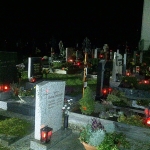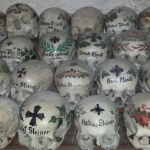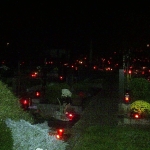
Angel Statue in St. Marx Cemetery in Vienna
“Der Tod muss ein Wiener sein…” (Death must be Viennese)
(Der Tod: Das muss ein Wiener sein , song title of 1969 song by Georg Kreisler)
On All Saints’ Day (November 1) and All Souls’ Day (November 2) the Viennese pilgrim to the cemeteries to light candles and pray for those who have passed (sometimes hoping to help them out of purgatory (or in German Fegefeuer sweeping fire)).
You don’t have to be here long to recognize that the Viennese have a special relationship with death. “Ein schönen Leich” (a beautiful corpse/ funeral) is as Viennese as the folk songs that cheerfully, acceptingly, ironically lament the inevitable fate of every human. And no blog about Vienna would be truly complete without mentioning death.
YOU CAN RING MY BELL , RING MY BELL…
THE FUNERAL MUSEUM OF VIENNA (Bestattungsmuseum)
For years this museum was listed as one of Vienna’s fun sites to see as in, “Hey, after we visit the Fool’s Tower (Narrenturm), let’s hit the Funeral Museum! Won’t that be fun!” Well, it was indeed interesting but unfortunately, the museum is closed until its reopening in September 2014 at Vienna’s Central Cemetery – a very fitting new home.

Church of Saint Charles Borromew in Vienna’s Central Cemetery
An interactive site at the museum was a bell with a long string attached to corpses in coffins. If someone was buried alive, he or she could theoretically ring the bell signaling the heroic funeral workers to spring to the rescue. The reality was, however, that due to postmortem spasms and unfortunate corpse positions, the bells rang non-stop and the heroic funeral workers not-so-heroically ignored them.
Which is probably why an Austrian playwright who was sometimes dubbed the “Austrian Shakespeare”, Johann Nestroy, feared being buried alive so much that he spent much of his last will and testament giving very specific instructions about measures he wanted taken to prevent this possibility. “The only thing I fear about death, is the idea that I could possibly be buried alive.” (January 31, 1861) Nestroy was generally a pretty funny guy but it seems he took being buried alive very seriously.
CEMETERY OF THE NAMELESS (Friedhof der Namenlosen)
“The goal of all life is death.” – Sigmund Freud
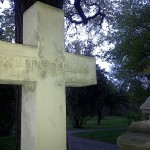
Tombstone “Wiedersehen” in St. Marx Cemetery Vienna
Vienna boasts over 40 Roman-Catholic cemeteries but those don’t do much good for the “weary of lifers” (Lebensmüde) who have plunged to their untimely deaths into the murky waters of the Danube. For many of those and others who have died namelessly and whose bodies have washed ashore, there’s the Cemetery of the Nameless. Most of the graves state simply “Unknown” or “Nameless.” Every year in November, the cemetery honors those who have never been recovered and whose remains still grace the Danube floor by launching a wreath down the the Danube towards the Black Sea. This year the ceremony will take place on Sunday, November 10, at 2 pm – gathering at the restaurant by the cemetery
VIENNESE LOVE STATUS EVEN IN DEATH
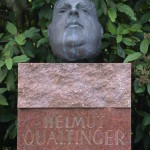
The honor grave of Austrian musical, theater and comedic legend, Helmut Qualtinger, at Central Cemetery in Vienna
Honorary graves were created in the Central Cemetery to up the prestige of the cemetery in the late 1800s a few years after the cemetery’s creation. Viennese are notorious for their initial skepticism to all that is new and in a brilliant 19th century PR move to increase the new cemetery’s popularity, the city of Vienna moved most of its prominent dead to “Honor Graves.” These include Brahms, Beethoven and Schubert – graves still popular today. Vienna grants the selected few Honor Graves for the life of the cemetery and assumes the costs for caring for the graves. In an interview in Austrian National Television, (ORF – link below) a reporter asks the man in charge of the grave honor what one has to do get an Honor Grave. His response? “Well, it’s not a very desirable achievement since the first thing you have to do is die.”
BUT DEATH MAKES NO DISTINCTIONS AND THREE TIMES A CHARM – EVEN WHEN YOU’RE DEAD (July 2011, Habsburg and the last Austrian royal funeral)
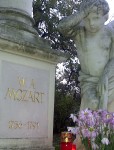
Mozart’s Grave in St. Marx Cemetery in Vienna
“Death as the true best friend of man.” – Wolfgang Amadeus Mozart
Since 1633, Austrian royalty has been buried in the Imperial Crypt under the Capuchin Church in Vienna. Some body parts, however, such as the hearts and intestines are buried elsewhere. Currently over 145 members of the House of Habsburg have their last resting place in the Imperial Crypt. When Otto von Habsburg passed in July 2011, a traditional royal funeral was held with all the pomp and circumstance and is said to be the last time an Austrian royal will ever be buried in the Imperial Crypt.
Open Sesame – watch the link above (July 2011) and here’s what you’re witnessing:
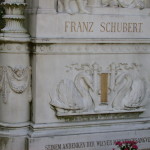
Schubert’s Tombstone at the Central Cemetery in Vienna
A Herald in a black suit leads the casket procession through the heart of old Vienna up to the Capuchin Church. The Herald knocks upon the iron gates with his long black cane. A Capuchin monk, whose brethren have held watch over the crypt since the 1600s, asks: “Who demands entry?”
After hundreds of years, you would think someone would have written down the right answer but nein. In attempts one and two, the Herald iterates an exhausting list of the the dead royal’s titles and accomplishments. Nearly three whole minutes. But the monks, being monks, are stoic and patient and simply respond, “Don’t know ’em.” (In all fairness to the monks, this seems a very benevolent response. After almost 4 centuries of conducting this ritual, I’d be a bit more testy with such slow students. Or maybe I’d paint a cheat sheet on the iron gate.)
Finally, upon the third attempt, eureka. The Herald responds, “Otto, a sinful mortal.”
Bingo! The gates open and the monks respond: “So then come inside.” (Monkese for, “Why didn’t you say so in the first place?”)
ST. MARX CEMETERY
“The biggest effort in life is not getting accustomed to death.” – Elias Canetti
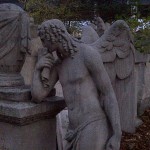
Angel on Tombstone at St. Marx’s Cemetery
I had never been to St. Marx and always wanted to go so this past weekend I went. Finally I managed to visit the place where Mozart’s bones are said to be buried somewhere in a mass grave. And I was not disappointed. Again, just when I thought I knew every single one of her little secrets, Vienna sprung a beauty on me. A wonderful surprise and a trip I highly recommend. I love this place. (Take bus 74A from the road that passes in front of Wien Mitte/ Landstrasse (on the U4 and U3 lines) to the station Hofmannsthalgasse – just a short hop and skip from there.)

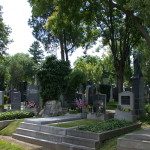
Central Cemetery, Vienna, one of the biggest cemetery’s in all of Europe

Cross marking Austrian Artist, Max Weiler’s burial place, Central Cemetery
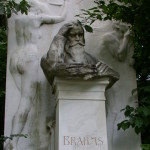
Tombstone of Johannes Brahms in Vienna’s Central Cemetery


